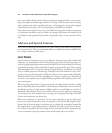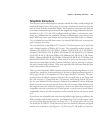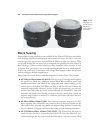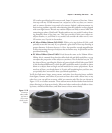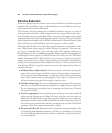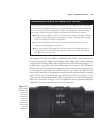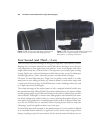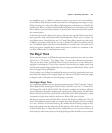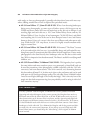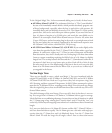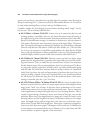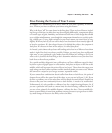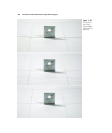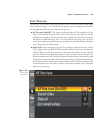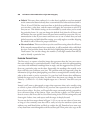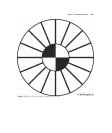
wide-angle, or close-up photography. I generally take these three lenses with me every-
where, adding another lens or two as required for specialized needs.
■ AF-S Zoom-Nikkor 17-35mm f/2.8D IF-ED. When I am shooting landscapes,
doing street photography, or some types of indoor sports, this lens goes on my
D7000 and never comes off. It was my main lens on my last trip to Europe; I was
traveling light and took this one, a 10-17mm Tokina fisheye zoom, and my 28-
200mm Nikkor G lens (in place of my humongous 70-200 VR lens), and didn’t
need anything else. It’s one of the two or three sharpest lenses I own, and focuses
down to about 1 foot, so I can use it for close-ups of flowers and other macro sub-
jects. With the DX 1.5X crop factor, it serves as a highly versatile medium wide-
angle to normal lens.
■ AF-S Zoom-Nikkor 28-70mm f/2.8D IF-ED. Nicknamed “The Beast” because
of its size and weight, this lens, too, is wonderfully sharp, and well-suited for any-
thing from sports to portraiture that falls within its focal length lens. I know many
photographers who aren’t heavily into landscapes who use this lens as their main
lens. With its impressive lens hood mounted, The Beast is useful for terrifying small
children, too.
■ AF-S VR Zoom-Nikkor 70-200mm f/2.8G IF-ED. This legendary lens is perfect
for some indoor and many outdoor sports, on a monopod, or hand-held, and can
be used for portraiture, street photography, wildlife (especially with the 1.4X tele-
converter), and even distant scenics. I use it for concerts, too, alternating between
this lens and my 85mm f/1.4. It takes me in close to the performer, and can be used
wide-open or at f/4 with good image quality. The only time I leave it behind is when
I need to travel light (although it’s not really that huge). This is the only lens of the
magic trio that lacks an aperture ring, but you probably won’t be using it with a bel-
lows extension, anyway.
David Busch’s Nikon D7000 Guide to Digital SLR Photography382
FULL-FRAME FOLLY?
The only “problem” with the original 70-200mm lens is that it produces noticeable
vignetting and reduced sharpness in the corners at many focal lengths when used on a
full-frame camera like the Nikon D3s/D3x, or D700. D7000 owners won’t see any of
these characteristics at all, because of the crop factor, and the vignetting and slight soft-
ness disappear on full-frame cameras when used with a 1.4X teleconverter. To be honest,
I’ve had wonderful results with this lens even with my full-frame cameras. I don’t shoot
landscapes or brick walls with 70 to 200mm focal lengths, and for the portrait and fash-
ion work I do, the corners aren’t important. If you plan to use your D7000 and a full-
frame Nikon camera, you should keep this “shortcoming” of the original 70-200mm
zoom in mind.



